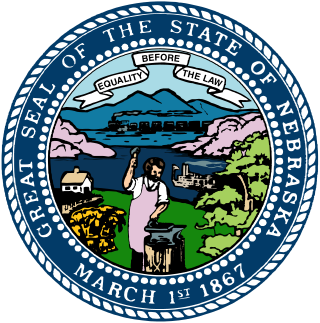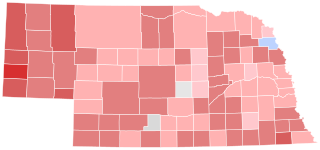
The 1986 United States Senate elections were elections for the United States Senate. Held on November 4, in the middle of Ronald Reagan's second presidential term, the 34 seats of Class 3 were contested in regular elections. The Republicans had to defend an unusually large number of freshman Senate incumbents who had been elected on President Ronald Reagan's coattails in 1980. Democrats won a net of eight seats, defeating seven freshman incumbents, picking up two Republican-held open seats, and regaining control of the Senate for the first time since January 1981. This remains the most recent midterm election cycle in which the sitting president's party suffered net losses while still flipping a Senate seat.

The 1972 United States Senate elections were held on November 7, with the 33 seats of Class 2 contested in regular elections. They coincided with the landslide re-election of Republican President Richard Nixon. Despite Nixon's landslide victory, Democrats increased their majority by two seats. The Democrats picked up open seats in Kentucky and South Dakota, and defeated four incumbent senators: Gordon Allott of Colorado, J. Caleb Boggs of Delaware, Jack Miller of Iowa, and Margaret Chase Smith of Maine. The Republicans picked up open seats in New Mexico, North Carolina, and Oklahoma, and defeated one incumbent, William B. Spong Jr. of Virginia.

The 1970 United States Senate elections was an election for the United States Senate. It took place on November 3, with the 33 seats of Class 1 contested in regular elections. Special elections were also held to fill vacancies. These races occurred in the middle of Richard Nixon's first term as president. The Democrats lost a net of three seats, while the Republicans and the Conservative Party of New York picked up one net seat each, and former Democrat Harry F. Byrd Jr. was re-elected as an independent.

The 1964 United States Senate elections were held on November 3. The 33 seats of Class 1 were contested in regular elections. Special elections were also held to fill vacancies. They coincided with the election of President Lyndon B. Johnson by an overwhelming majority, to a full term. His Democratic Party picked up a net two seats from the Republicans. As of 2023, this was the last time either party has had a two-thirds majority in the Senate, which would have hypothetically allowed the Senate Democrats to override a veto, propose constitutional amendments, or convict and expel certain officials without any votes from Senate Republicans. In practice, however, internal divisions effectively prevented the Democrats from doing so. The Senate election cycle coincided with Democratic gains in the House in the same year.

The 1960 United States Senate elections coincided with the election of John F. Kennedy as president on November 8, 1960. The 33 seats of Class 2 were contested in regular elections. A special election was also held on June 28, 1960, for a mid-term vacancy in North Dakota where Democrats flipped a seat to expand their majority to 66–34. As Majority Leader Lyndon Johnson was elected Vice President, Mike Mansfield became the new majority leader.

The 1958 United States Senate elections were elections for the United States Senate which occurred in the middle of President Dwight D. Eisenhower's second term. Thirty-two seats of Class 1 were contested in regular elections, the new state of Alaska held its first Senate elections for its Class 2 and 3 seats, and two special elections were held to fill vacancies.

The 1954 United States Senate elections was a midterm election in the first term of Dwight D. Eisenhower's presidency. The 32 Senate seats of Class 2 were contested in regular elections, and six special elections were held to fill vacancies. Eisenhower's Republican party lost a net of two seats to the Democratic opposition. This small change was just enough to give Democrats control of the chamber with the support of an Independent who agreed to caucus with them, he later officially joined the party in April 1955.

The 1936 United States Senate elections coincided with the reelection of President Franklin D. Roosevelt. The 32 seats of Class 2 were contested in regular elections, and special elections were held to fill vacancies. The Great Depression continued and voters backed progressive candidates favoring Roosevelt's New Deal in races across the country. The Democrats gained 5 net seats during the election, and in combination with Democratic and Farmer–Labor interim appointments and the defection of George W. Norris from the Republican Party to become independent, the Republicans were reduced to 16 seats. Democrats gained a further two seats due to mid-term vacancies. The Democrats' 77 seats and their 62-seat majority remain their largest in history.

Don Stenberg is an American lawyer and politician who served as the 31st Attorney General of Nebraska from 1991 to 2003 and 43rd Treasurer of Nebraska from 2011 to 2019. A member of the Republican Party, he previously was legal counsel to Governor Charles Thone from 1979 to 1983.

The 1912–13 United States Senate elections were held on various dates in various states. They were the last U.S. Senate elections before the ratification of the Seventeenth Amendment in 1913, establishing direct elections for all Senate seats. Senators had been primarily chosen by state legislatures. Senators were elected over a wide range of time throughout 1912 and 1913, and a seat may have been filled months late or remained vacant due to legislative deadlock. Some states elected their senators directly even before passage of Seventeenth Amendment. Oregon pioneered direct election and experimented with different measures over several years until it succeeded in 1907. Soon after, Nebraska followed suit and laid the foundation for other states to adopt measures reflecting the people's will. By 1912, as many as 29 states elected senators either as nominees of their party's primary or in conjunction with a general election.

Terry McGovern Carpenter was an American politician. Though he changed his party five times, he was elected as a Democrat to the United States House of Representatives and later served 22 years in the Nebraska Legislature. He also unsuccessfully ran for the Senate, Governor and Lieutenant Governor of Nebraska, and also unsuccessfully and then subsequently successfully for mayor of Scottsbluff, Nebraska. Carpenter was also a successful businessman and founded the village of Terrytown, Nebraska.

The 1934 United States Senate election in Tennessee was held on November 5, 1934. Incumbent Democratic Senator Kenneth D. McKellar was re-elected to a fourth term in office, defeating Republican former Governor Ben W. Hooper.

The 1934 United States Senate election in Nebraska took place on November 6, 1934. A special election was held on the same day for the same seat. The incumbent Senator, Republican Robert B. Howell, died on March 11, 1933. William Henry Thompson, a Democratic politician, was appointed to the vacant seat. Richard C. Hunter was elected to finish Howell's term, while Burke was elected to the next term, defeating Robert G. Simmons. This was the last time until 1976 that a Democrat won a Senate election in Nebraska.

The 1932 United States Senate election in North Carolina was held on November 8, 1932. Interim Democratic Senator Cameron A. Morrison ran for election to a full term, but was defeated in the Democratic primary by Robert Rice Reynolds. Reynolds defeated Republican Jacob F. Newell in the general election.

The 2014 U.S. House of Representatives elections in Nebraska were held on Tuesday, November 4, 2014 to elect 3 members of the U.S. House of Representatives from the state of Nebraska, one from each of the state's three congressional districts. The elections coincided with the elections of other federal and state offices, including the governor of Nebraska and a United States senator. Primary elections to determine candidates in the general election were held on Tuesday, May 13, 2014. The members elected at this election will serve in the 114th Congress.

The 2016 United States House of Representatives elections in Nebraska were held on November 8, 2016, to elect the three U.S. representatives from the state of Nebraska, one from each of the state's three congressional districts. The elections coincided with the 2016 U.S. presidential election, as well as other elections to the House of Representatives, elections to the United States Senate and various state and local elections. The primaries were held on May 10.

The 1942 United States Senate election in Nebraska was held on November 3, 1942.

The 1948 United States Senate election in Nebraska took place on November 2, 1948. Senate Majority Whip Kenneth S. Wherry was re-elected to a second term, defeating former Representative Terry Carpenter. He won by a larger margin than 1942, due to the absence of a third party candidate. Wherry overperformed Republican presidential candidate Thomas Dewey by 2.55%, who won the state with 54.15% in the presidential election.

The 1924 United States Senate election in Nebraska took place on November 4, 1924. The incumbent Republican, George W. Norris, was re-elected by a wide margin to a third term. He defeated John J. Thomas. Norris overperformed Calvin Coolidge, who won the state with 47.09% in the presidential election.

The 2020 United States House of Representatives elections in Nebraska was held on November 3, 2020, to elect the three U.S. representatives from the state of Nebraska, one from each of the state's three congressional districts. The elections coincided with the 2020 U.S. presidential election, as well as other elections to the House of Representatives, elections to the United States Senate and various state and local elections.




















